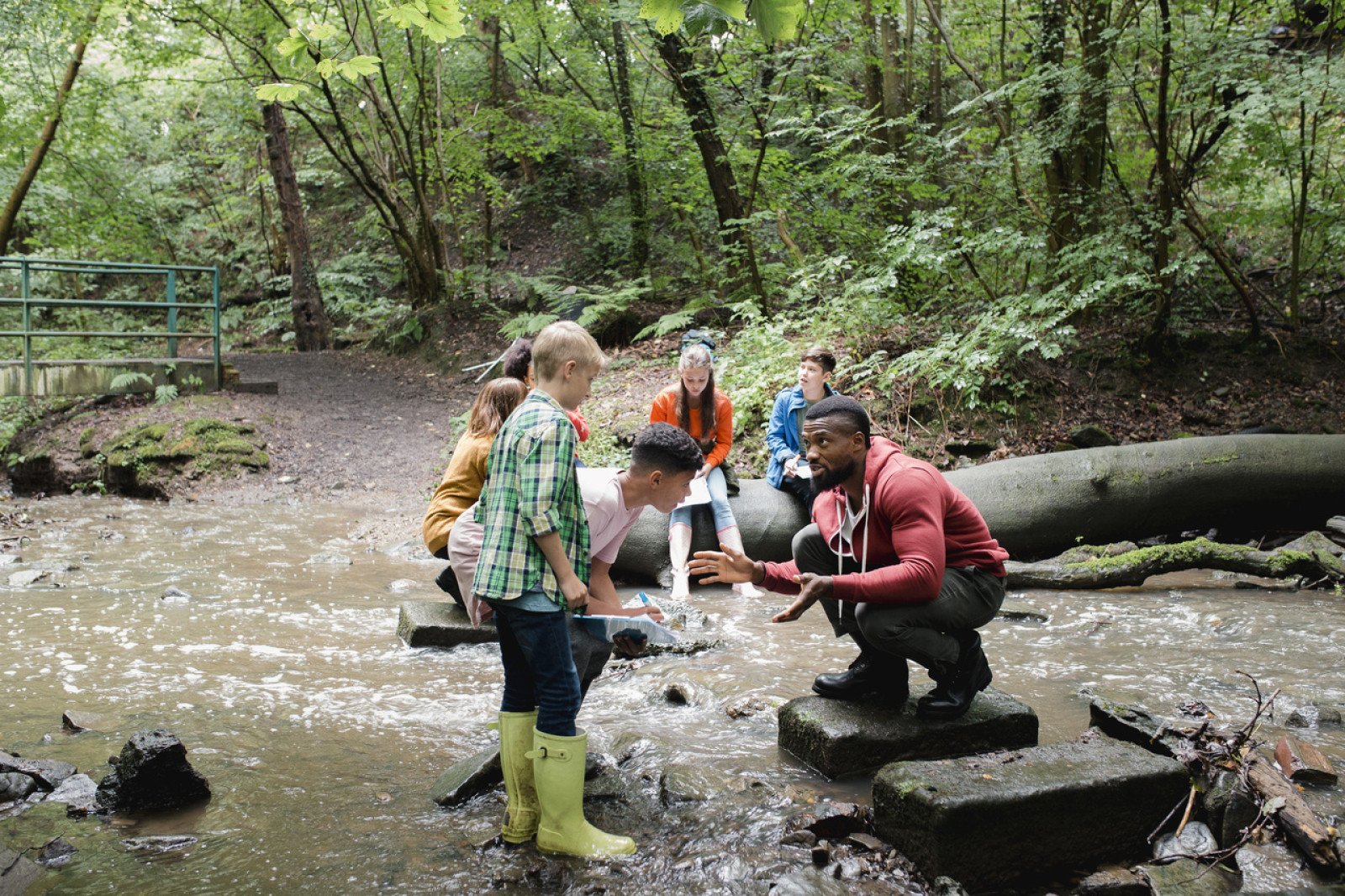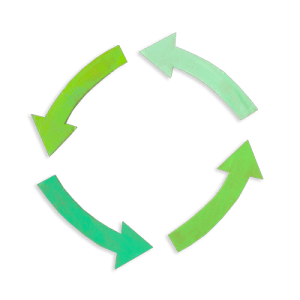
Overview
To learn more about Indigenous Peoples’ relationship with water, students examine poetry and images that describe water. Guided by criteria, students suggest vivid words that could be used to describe water.
Instructions
What you'll need
- "Describing how water moves" slides
- "Describing water" worksheet
- Digital projector and screen
- Open up the "Describing how water moves" slides. Show your students slide 2 and ask them, “What words and phrases can we use to describe water?” Note their suggestions, and then use their thinking to create or present criteria for vivid descriptive words. A vivid word or phrase:
- Accurately describes the object
- Helps the reader see, feel, or hear what is being described
- Invite your students to revisit the class visit of descriptive words and phrases, this time using the criteria to select the most vivid words and phrases.
- Provide each student with a copy of the "Describing water" worksheet and guide their attention to the “My first thoughts” section. Ask your students to write down vivid words that could be used to describe water. Explain that they will choose four words to create a poem or a picture of water (assure your students that they can revisit and rethink their words throughout this activity).
- Show your students slide 3 and read the poem together. Ask your students to listen or watch for vivid words that describe water. Add these words to the class list. Alternatively, you could read one of the books suggested in the Teaching Notes section.
- Show slides 4-6 and read about First Peoples’ beliefs about water. Ask students to look for any additional vivid words and phrases that could be used to describe water.
- Show slides 7-13 and ask your students to think of vivid words to describe water. Encourage your students to add vivid words to the “My first thoughts” section of their worksheet.
- Ask your students to review all the words that they’ve collected in the “My first thoughts” section and to make a decision: which words and phrases are the most vivid? Remind them to use the criteria when making their decision. Guide them to write their selected words in the “My four most vivid words” section.
- Conclude the activity by asking your students to use their four best descriptive words to create a short poem or diagram about water. Encourage them to think about how their words can be used to teach others about respecting and honouring water. Play the "Honouring water" video as an example of how the Leq'a:mel Nation in British Columbia honours water.
Modify or extend this activity
Extensions
- Ask students to use their vivid words to create a poem or drawing to help others understand the importance of respecting and honouring water.
- Play a game outside or in the gym where students select a vivid word that describes water and then demonstrate the movement.
Curriculum Fit
Grade 2 Science
Big idea
- Water is essential to all living things, and it cycles through the environment
Content
- Local First People’s knowledge of water:
- Conservation
- Water sources
Curricular competencies
Questioning and predicting
- Demonstrate curiosity and a sense of wonder about the world
Processing and analyzing data and information
- Recognize First Peoples stories, songs and art as a way to share knowledge
- Sort and classify data and information using drawings, pictographs and provided tables
Evaluating
- Compare observations with those of others
Grade 2 English Language Arts
Big ideas
- Language and story can be a source of creativity and joy
- Through listening and speaking, we connect with others and share our world
- Playing with language helps us discover how language works
Content
- Literary elements and device
- Vocabulary associated with texts
- Language features, structures, and conventions:
- Features of oral language
Curricular competencies
Comprehend and connect (reading, listening, viewing)
- Use sources of information and prior knowledge to make meaning
- Show awareness of how story in First Peoples cultures connects people to family and community
Create and communicate (writing, speaking, representing)
- Exchange ideas and perspectives to build shared understanding
- Plan and create a variety of communication forms for different purposes and audiences
Grade 3 Social Studies
Big ideas
- Learning about indigenous peoples nurtures multicultural awareness and respect for diversity
- Indigenous societies throughout the world value the well-being of the self, the land, spirits, and ancestors
Content
- Cultural characteristics and ways of life of local First Peoples and global Indigenous peoples
- Relationship between humans and their environment
Curriculum competencies
- Use Social Studies inquiry processes and skills to ask questions; gather, interpret, and analyze ideas; and communicate findings and decisions
- Ask questions, make inferences, and draw conclusions about the content and features of different types of sources (evidence)
- Explain why people’s beliefs, values, worldviews, experiences, and roles give them different perspectives on people, places, issues, or events
Assessments
Assess students’ ability to:
- Think collaboratively during class discussions.
- Use criteria to guide their thinking.
- Use sources of information and prior knowledge to make meaning.
- Transfer and apply learning to new situations.
Teaching Notes
Indigenous Peoples' belief about water
- Water is very sacred for Indigenous Peoples.
- It symbolizes purity and life and should be treated with respect.
- Water is alive.
- It has a living spirit.
- It is always moving and connecting in rhythms.
- Water is meant to meander.
- There is an energy in its movement.
- Indigenous Peoples have many names for water.
- The names reflect what water does, how it looks and how it moves.
- Water is very sacred for Indigenous people.
- It symbolizes purity and life and has a living spirit.
- Water is the most life sustaining gift on Mother Earth and it connects all living things.
- Water shapes the land and gives us the great gifts of the rivers, lakes, ice and oceans.
Books that could be used to explore Indigenous Peoples’ relationship with water include:
- The Water Walker (Joanne Robertson)
- sk?p'lk'mitkw / Water Changeling (Harron Hall)
How this activity was developed
These materials were created with guidance from Indigenous educators, subject matter experts and thought leaders to help draw upon important teachings, learnings, and Indigenous perspectives.
For centuries, the traditional western view of water has often been focused on its value as a resource. Indigenous People have a unique relationship with the waters of British Columbia. Since time immemorial, water has played a sacred role and is seen as a living entity. How water is used must be carefully considered with a view towards not just the immediate need and impact, but the needs and perspectives of generations to follow.
We are dedicated to deep listening and respectfully highlighting Indigenous ways of knowing in the materials we provide B.C. educators. If you have any feedback for us on these activities, or suggestions for others, please email schools@bchydro.com. We would love to hear from you.
About the artist
The design of the worksheets in this activity was a collaborative effort with Indigenous artist Kelli Clifton. Kelli Clifton was born and raised in Prince Rupert, British Columbia and is Gitga’at from the community of Hartley Bay. Clifton is interested in using her artwork as a form of storytelling—especially in relation to her Ts’msyen language (Sm’algyax), her coastal upbringing and her experiences as an Indigenous woman. Clifton currently lives in her home community where she continues to practice her art and teaches Sm’algyax at a local high school. Learn more about Clifton's art on her Facebook page.
BC Hydro’s commitment to reconciliation
BC Hydro exists to serve British Columbians by providing clean, reliable and affordable electricity. We recognize that maintaining and developing the system has impacts on the lives and interests of Indigenous People. To support our move towards true and lasting reconciliation, BC Hydro will acknowledge past wrongs, listen to Indigenous perspectives and seek shared understanding with First Nations communities and governments.
Learn more about our Statement of Indigenous Principles.







